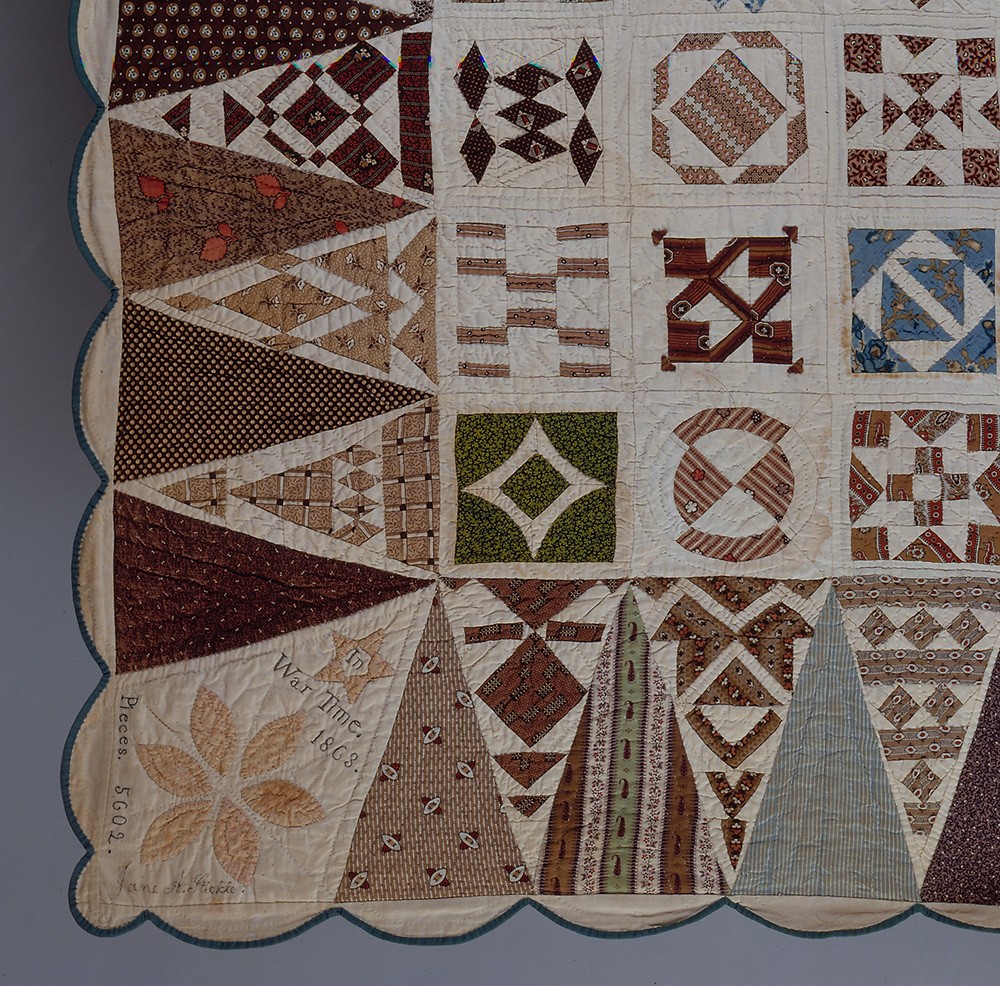FOR IMMEDIATE RELEASE: August 15, 2019
Contact: Susan Strano, Marketing Coordinator
[email protected]
Image: Stickle Quilt (detail)
Sampler Quilt, 1863
Jane A. Stickle (1817-1896)
Pieced cotton with linen backing

Inspiring Quilters around the World
From August 31 through October 14, the quilt that inspires quilters around the world will be on its annual display at Bennington Museum. Brought into the Museum collection 80 years ago, the 1863 Jane Stickle Quilt is only shown for a short time each year due to the fragility of the fabric. Quilters from around the country and world plan trips to the region during that time to see the remarkable quilt which is comprised of 169 five-inch blocks, each in different patterns and a unique fabric, containing a total of 5,602 pieces surrounded by a unique scalloped border.
Sampler quilts, comprised of numerous equally sized blocks each in a different pattern, were fairly common during this period. However, each block was typically pieced by a different person. While the average size of a quilt block was 8 to 12 inches square, those in the Stickle quilt measure 4 to 5 inches square. Many of the blocks are intricately pieced, with pieces ranging in size from less than a quarter of an inch to 2 inches on a side and some of the blocks having as many as thirty-five to forty pieces. The small size and sheer quantity of the uniquely patterned blocks in Stickle’s quilt is especially notable. Many block patterns are commonly seen in quilts from this era, however many more are unique, drafted by a skilled needle worker with a mastery of geometry. This advanced level of craftsmanship is found in the Stickle quilt.
Jane Stickle was born Jane Blakely on April 8, 1817 in Shaftsbury, Vermont. In 1831, at the age of 13, Jane’s father, Erastus Blakely, died leaving a quarter of his estate to his daughter, ensuring her continued education. During the 1830s, local academies taught both geometry and painting, skills Stickle had clearly mastered and made use of in the creation of her quilt. A talented artist, she was educated and had an artistic eye. She used both in effectively raising her quilt from an elaborate bedcover or feat of needleworking skills, to that of a truly remarkable work of art. “The significance of quilts, with their vibrant colors and precise geometric patterns, goes beyond the comforting, everyday use they received by their original owners. Today, within the context of museums, these early textiles can be re-envisioned as works of art on par with any abstract painting of the twentieth century. The Stickle quilt, with its dizzying array of printed cloth patterns and individual block designs, surely embodies this idea of quilt as art,” states Jamie Franklin, curator of the Bennington Museum.
A discovery made this past decade helps explain why a middle-aged woman was able to dedicate a great deal of time to the creation of a quilt. In a report on the Bennington County Agricultural Fair dated October 1, 1863, published in the Bennington Banner, the reporter stated that “Mrs. J. B. Smith of Manchester, Mrs. Taft and Mrs. Stickles presented each a very extra bed quilt. Mrs. Stickles is an invalid lady, having been for a long time confined to her bed, but her ambition to do something to kill the time induced her to piece this quilt. It contains many thousand different pieces of cloth, no two of which are exactly alike. Upon one corner is marked in plain letters, “made in the war of 1863.” (Note: inscription here is slightly wrong as it accurately reads “In War Time 1863”) Knowing that Jane Stickle was bed ridden helps to better understand how a farm wife at the prime of her life would have had the time/inspiration to undertake such an elaborate, time-consuming project.
On October 8, of the same year, the Bennington Banner published a list of “premiums” awarded at the fair. It is noted that the “Best patched quilt” was awarded to “Mrs. W. P. Stickles” with a prize of $2, equivalent to about $40 in today’s money. Modest when compared to her remarkable accomplishment, it is nice to know that Stickle’s quilt was recognized by her contemporaries, and that it continues to inspire quilters to this day.
About the Museum
Bennington Museum is located at 75 Main Street (Route 9), Bennington, in The Shires of Vermont. The Museum is open 10 am to 5 pm daily June through October. It is wheelchair accessible. Regular admission is $10 for adults, $9 for seniors and students over 18. Admission is never charged for younger students, museum members, or to visit the museum shop. Visit the museum’s website www.benningtonmuseum.org or call 802-447-1571 for more information.
